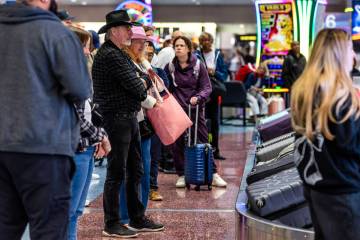Rising fuel prices buck trends
'Tis the season for quirky economic data, from unprecedented drops in state taxable sales to an unusual national pairing of flat incomes and rising consumer spending.
Now, we have one more head-scratcher for you.
Fuel prices typically weaken in late summer, as vacation season winds down and demand for gasoline dwindles. But that hasn't happened this year: A gallon of regular, unleaded gasoline sold for $2.72 in Las Vegas on Friday, up from $2.56 a month ago, according to travel club AAA. Prices have risen even as demand mostly stayed steady. What gives?
This summer, demand alone isn't driving fuel prices, observers say. A number of factors have pushed up the cost of crude oil in recent weeks, and because petroleum makes up more than half a gallon of gasoline, any price spike in the commodity will show up in fuel prices.
Oil closed at $72.74 a barrel Friday, up from around $60 in July. And each $1 change in the price of a barrel of crude moves prices at the pump 2.5 cents a gallon on average, said James Halloran, principal of Russell Energy Advisors, an affiliate of Financial America Securities in Cleveland.
Considering how much excess oil supply the world has, crude's most recent price runs a little high, Halloran said. He and other observers say they think oil should cost around $60 a barrel these days.
Blame the pricey crude on investor interest and a weak American dollar, among other causes.
A flood of reports heralding the potential bottom of the national recession has investors betting that an improving economy will push up demand for gasoline.
"It's like a Pavlov's-dog reaction. Every time we see a positive report, people funnel money into crude oil because they think the economy may be turning around," said Michael Geeser, a spokesman for AAA.
Indeed, the market seems to expect higher prices in the longer term. Futures on crude scheduled for delivery in August 2010 show a trading price on the New York Mercantile Exchange of $78.80 a barrel, up slightly from Friday's close.
Investors aren't driving fuel costs by themselves, though. A declining U.S. dollar also means higher oil and gasoline prices.
Crude trades globally in dollars. When the Chinese buy petroleum from Saudi Arabia, they purchase it with American dollars, Halloran noted. With a weaker dollar, crude sellers will insist on more dollars for a barrel of oil.
Halloran said he doesn't expect any substantial changes in oil or gasoline prices before November.
Fuel prices should tick down a couple of cents per gallon through Thanksgiving, partly because the refineries that transform crude into gasoline have massive supplies relative to their manufacturing capacity. The nation's refineries operate today at 84 percent of their output capability overall, compared with the 92 percent that's typical in late summer. With 16 percent of capacity idled, profits shrink.
And with people driving fewer miles than they drove before the recession, gasoline inventories remain well above their five-year averages, Halloran said. Refiners hold so much excess fuel that the usual autumn refinery shutdowns for the conversion to winter-fuel blends shouldn't even register a blip in prices at the pump, he said.
Other analysts say they expect oil prices to sustain their advance through 2009's end, despite high supplies and constricted demand.
Michael Fitzpatrick, vice president of energy with New York trading firm MF Global, said his company forecasts a year-end average crude price of $96 a barrel.
"Investor demand is so high right now. Investors are betting on higher prices," Fitzpatrick said. "One of the factors that grew prices a year ago was a lack of refining space. As demand returns -- and invariably, it will -- that will happen again."
Fitzpatrick said he also expects continued investor "wariness" about buying positions in financial assets. With the collapse of Lehman Bros. and other investment banks still fresh in traders' memories, buyers prefer tangible assets such as commodities. There's also concern about how economic-stimulus programs around the world will affect currency values, and how those monetary values will impact oil prices.
But the economy will remain the biggest factor moving oil prices, Halloran said.
If financial markets stay strong, and if consumers and investors develop bullish, optimistic attitudes on economic improvement, expect gasoline and other related commodities to grow more expensive.
"It's like the old saying about real estate. The three things that matter most are location, location and location," Halloran said. "The three things that matter with oil prices are the economy, the economy and the economy."
If fuel prices do rise considerably in coming months, consumers will likely reach a breaking point far more quickly than they did in 2008, when prices shot to $4 a gallon before motorists relented and tweaked their driving habits. Fitzpatrick pointed to rising savings -- the country's savings rate went from zero in mid-2008 to 7 percent today -- as evidence that consumers remain worried about job loss and home foreclosure. That means consumers would modify their driving habits far ahead of $4 a gallon, Fitzpatrick said.
Contact reporter Jennifer Robison at jrobison@reviewjournal.com or 702-380-4512.
THE PUMP IN PERSPECTIVE
Gasoline prices have risen in recent weeks nationally and locally, but consumers still pay far less at the pump than they did a year ago. Here are some historical averages for a gallon of regular, unleaded gasoline:
United States
Friday $2.61
July 28 $2.51
August 28, 2008 $3.66
Record $4.11 (July 17, 2008)
Nevada
Friday $2.77
July 28 $2.62
August 28, 2008 $3.76
Record $4.27 (June 20, 2008)
Las Vegas
Friday $2.72
July 28 $2.56
August 28, 2008 $3.70
Record $4.28 (June 21, 2008)
SOURCE: AAA

















